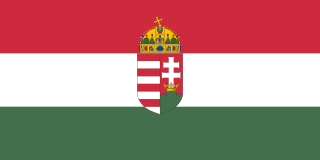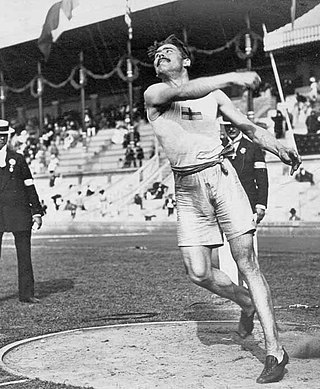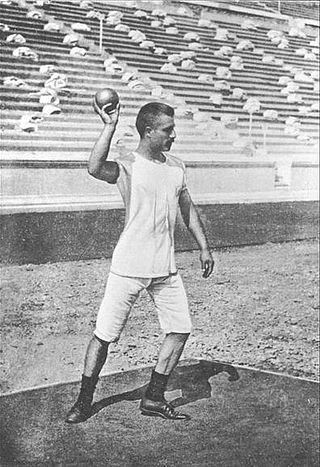
The javelin throw is a track and field event where the javelin, a spear about 2.5 m in length, is thrown as far as possible. The javelin thrower gains momentum by running within a predetermined area. Javelin throwing is an event of both the men's decathlon and the women's heptathlon.
Urho Pellervo Peltonen was a Finnish athlete who competed mainly in the javelin throw.

Norway competed at the 1912 Summer Olympics in Stockholm, Sweden. 190 competitors, 188 men and 2 women, took part in 58 events in 14 sports.

Hungary competed at the 1912 Summer Olympics in Stockholm, Sweden. Austrian and Hungarian results at early Olympic Games are generally kept separate despite the union of the two nations as Austria-Hungary at the time. 121 competitors, all men, took part in 52 events in 11 sports.

Finland competed at the 1912 Summer Olympics in Stockholm, Sweden. The Grand Duchy of Finland was an autonomous part of the Russian Empire at the time, which allowed Finland to compete separately of Russia Russia at the 1908 Summer Olympics due to Finland's special status. During the opening ceremony, Finland's team paraded under the national insignia flag of a Swedish-speaking female gymnastics club in Helsinki. 164 competitors, 162 men and 2 women, took part in 49 events in 10 sports.

Finland competed at the 1920 Summer Olympics in Antwerp, Belgium for the first time as a fully independent state. It competed independently in 1908 and 1912 as the autonomous Grand Duchy of Finland within the Russian Empire. 63 competitors, 62 men and 1 woman, took part in 51 events in 9 sports.

Greece competed at the 1912 Summer Olympics in Stockholm, Sweden. 22 competitors, all men, took part in 25 events in five sports. Greek athletes have competed in all Summer Olympic Games.
Móric "Mór" Kóczán was a Slovak–Hungarian athlete and Calvinist pastor. Specialized for the throwing events, his best results came in the javelin throw, having won five Hungarian championship titles between 1911 and 1918. Kóczán competed for Hungary at the 1908 Summer Olympics and 1912 Summer Olympics. He produced his best performance in 1912 by winning the bronze medal in the javelin throw event.

The men's long jump was a track and field athletics event held as part of the athletics at the 1912 Summer Olympics programme. The competition was held on Friday, July 12, 1912. Thirty long jumpers from 13 nations competed. NOCs could enter up to 12 athletes. The event was won by Albert Gutterson of the United States, the nation's fifth gold medal in the event in five Games. Calvin Bricker of Canada became the second man to win a second medal in the long jump, adding a silver to his 1908 bronze. Sweden won its first long jump medal with Georg Åberg's bronze.

The men's shot put was a track and field athletics event held as part of the athletics at the 1912 Summer Olympics programme. The competition was held on Wednesday, July 10, 1912. Twenty-two shot putters from 14 nations competed. NOCs could enter up to 12 athletes. The event was won by Pat McDonald of the United States, the nation's fifth consecutive victory in the men's shot put. The American team swept the top three places, the third time in five Games. Ralph Rose took silver, 9 centimetres shy of a third gold medal; he became the first man to win three medals of any color.

The men's discus throw was a track and field athletics event held as part of the athletics at the 1912 Summer Olympics programme. The competition was held on Friday, July 12, 1912. Forty-one discus throwers from 15 nation competed. NOCs could enter up to 12 athletes. The event was won by Armas Taipale of Finland, the nation's first medal in the men's discus throw. Richard Byrd took silver and James Duncan took bronze to continue the United States' podium streak at five consecutive Games.

The men's hammer throw was a track and field athletics event held as part of the athletics at the 1912 Summer Olympics programme. It was the fourth appearance of the event, which had been won all three previous times by John Flanagan. The competition was held on Sunday, July 14, 1912. Fourteen hammer throwers from four nations competed. NOCs could enter up to 12 athletes. The event was won by Matt McGrath of the United States, the nation's fourth consecutive victory in the event. McGrath was the second man to earn multiple medals in the hammer throw. Duncan Gillis of Canada took silver. Clarence Childs of the United States finished third for bronze.

The men's javelin throw was a track and field athletics event held as part of the athletics at the 1912 Summer Olympics programme. It was the second appearance of the event, but in 1908 it was a standing throw with no run up. The competition was held on Saturday, July 6, 1912. Twenty-five javelin throwers from seven nations competed. NOCs could enter up to 12 athletes.

The men's two handed shot put was a track and field athletics event held as part of the Athletics at the 1912 Summer Olympics programme. It was the only appearance of the event at the Olympics, along with the other two handed throws. The format of the event was such that each thrower threw the shot three times with his right hand and three times with his left hand. The best distance with each hand was summed to give a total. The three finalists received three more throws with each hand. The competition was held on Thursday, July 11, 1912. Seven shot putters from five nations competed. NOCs could enter up to 12 athletes.

The men's two handed discus throw was a track and field athletics event held as part of the Athletics at the 1912 Summer Olympics programme. It was the only appearance of the event at the Olympics, along with the other two handed throws. The format of the event was such that each thrower threw the discus three times with his right hand and three times with his left hand. The best distance with each hand was summed to give a total. The three finalists received three more throws with each hand. The competition was held on Saturday, July 13, 1912. Twenty discus throwers from six nations competed. NOCs could enter up to 12 athletes.
The men's pentathlon was a track and field athletics event held as part of the Athletics at the 1912 Summer Olympics programme. It was the first time the event was held. Twenty-six athletes from 11 nations competed. NOCs could enter up to 12 athletes. Jim Thorpe's gold medal was the first ever won by an Indigenous American athlete in Olympic history.

The shot put at the Summer Olympics is one of four track and field throwing events held at the multi-sport event. The men's shot put has been present on the Olympic athletics programme since 1896. The women's event was added to the programme at the 1948 Olympics just over fifty years later.

The discus throw is one of four track and field throwing events held at the Summer Olympics. The men's discus throw has been present on the Olympic athletics programme since 1896. The women's event was first contested at the 1928 Olympics, being one of the five athletics events in the inaugural Olympic women's programme.

The javelin throw at the Summer Olympics is one of four track and field throwing events held at the multi-sport event. The men's javelin throw has been present on the Olympic athletics programme since 1908, being the last of the current throwing events to feature at the Olympics after the shot put, discus throw and hammer throw. The women's event was first contested at the 1932 Olympics, becoming the second women's throws event after the discus in 1928.

Combined events at the Summer Olympics have been contested in several formats at the multi-sport event. There are two combined track and field events in the current Olympic athletics programme: a men's decathlon and a women's heptathlon.
















